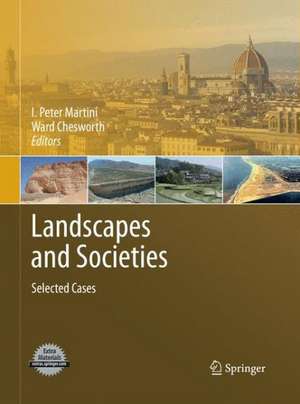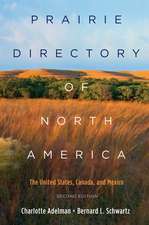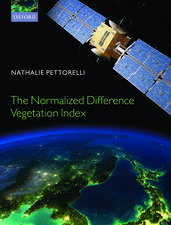Landscapes and Societies: Selected Cases
Editat de I. Peter Martini, Ward Chesworthen Limba Engleză Paperback – 26 noi 2014
Comparisons and contrasts between the various cases can be made at various scales from global through inter-regional, to regional and smaller scales. At the global scale, all societies deal with major problems of climate change, sea-level rise, and with ubiquitous problems such as soil erosion and landscape degradation. Inter-regional differences bring out significant detail with one region suffering from drought when another suffers from widespread flooding. For example, desertification in North Africa and the Near East contrasts with the temperate countries of southern Europe where the landscape-effects of deforestation are more obvious. And China and Japan offer an interesting comparison from the standpoint of geological hazards to society - large, unpredictable and massively erosive rivers in the former case, volcanoes and accompanying earthquakes in the latter. Within the North African region localized climatic changes led to abandonment of some desertified areas with successful adjustments in others, with the ultimate evolution into the formative civilization of Egypt, the "Gift of the Nile". At a smaller scale it is instructive to compare the city-states of the Medieval and early Renaissance times that developed in the watershed of a single river, the Arno in Tuscany, and how Pisa, Siena and Florence developed and reached their golden periods at different times depending on their location with regardto proximity to the sea, to the main trunk of the river, or in the adjacent hills.
Also noteworthy is the role of technology in opening up opportunities for a society. Consider the Netherlands and how its history has been formed by the technical problem of a populous society dealing with too much water, as an inexorably rising sea threatens their landscape; or the case of communities in Colorado trying to deal with too little water for farmers and domestic users, by bringing their supply over a mountain chain.
These and others cases included in the book, provide evidence of the successes, near misses and outright failures that mark our ongoing relationship with landscape throughout the history of Homo sapiens. The hope is that compilations such as this will lead to a better understanding of the issue and provide us with knowledge valuable in planning a sustainable modus vivendi between humanity and landscape for as long as possible.
Audience: The book will interest geomorphologists, geologists, geographers, archaeologists, anthropologists, ecologists, environmentalists, historians and others in the academic world. Practically, planners and managers interested in landscape/environmental conditions will find interest in these pages, and more generally the increasingly large body of opinion in the general public, with concerns about Planet Earth, will find much to inform their opinions.
Extra material: The color plate section is available at http://extras.springer.com
| Toate formatele și edițiile | Preț | Express |
|---|---|---|
| Paperback (1) | 820.89 lei 39-44 zile | |
| SPRINGER NETHERLANDS – 26 noi 2014 | 820.89 lei 39-44 zile | |
| Hardback (1) | 829.44 lei 39-44 zile | |
| SPRINGER NETHERLANDS – 11 noi 2010 | 829.44 lei 39-44 zile |
Preț: 820.89 lei
Preț vechi: 1080.12 lei
-24% Nou
Puncte Express: 1231
Preț estimativ în valută:
157.08€ • 167.97$ • 130.97£
157.08€ • 167.97$ • 130.97£
Carte tipărită la comandă
Livrare economică 14-19 aprilie
Preluare comenzi: 021 569.72.76
Specificații
ISBN-13: 9789400790254
ISBN-10: 9400790252
Pagini: 496
Ilustrații: XVIII, 478 p.
Dimensiuni: 193 x 260 x 26 mm
Greutate: 1.03 kg
Ediția:2011
Editura: SPRINGER NETHERLANDS
Colecția Springer
Locul publicării:Dordrecht, Netherlands
ISBN-10: 9400790252
Pagini: 496
Ilustrații: XVIII, 478 p.
Dimensiuni: 193 x 260 x 26 mm
Greutate: 1.03 kg
Ediția:2011
Editura: SPRINGER NETHERLANDS
Colecția Springer
Locul publicării:Dordrecht, Netherlands
Public țintă
ResearchCuprins
Preface
List of contributors
List of reviewers
Part I. Introduction
1. Summaries of the contributions and a few considerations; I. Peter Martini and Ward Chesworth
2. A semantic introduction; Ward Chesworth
3. Womb, belly and landscape in the Anthropocene; Ward Chesworth
Part II. The Mediterranean and European world-arid Mediterranean lands
4. Human responses to climatically-driven landscape change and resource scarcity: Learning from the past and planning for the future; Nickolas Brooks
5. Human communities in a drying landscape: Holocene climate change and cultural response in the central Sahara; Mauro Cremaschi and Andrea Zerboni
6. The desertification of the Egyptian Sahara during the Holocene (the last 10,000 years) and its influence on the rise of Egyptian civilization; Michael Brookfield
7. Paleoenvironments and prehistory in the Holocene of SE Arabia; Andrew S. Goudie and Adrian G. Parker
8. Human paleoecology in the ancient metal-smelting and farming complex in the Wadi Faynan, SW Jordan, at the desert margin in the Middle East; Chris Hunt and Hwedi el-Rishi
9. Empire and Environment in the Northern Fertile Crescent; Tony J. Wilkinson
Part III. The Mediterranean and European world warm-temperate Mediterranean lands
10. The interplay between environment and people from Neolithic to classical times in Greece and Albania; Eric Fouache and Kosmas Pavlopoulos
11. The Nuragic people: Their settlements, economic activities and use of the land, Sardinia, Italy; Anna Depalmas and Rita T. Melis
12. Floods, mudflows, landslides: adaptation of Etruscan–Roman communities to hydrogeological hazards in the Arno River catchment (Tuscany, Central Italy); Marco Benvenuti et al
13. Landscape influenceson the development of the Medieval–Early Renaissance city-states of Pisa, Florence, and Siena, Italy; I. Peter Martini et al
14. Paleo-hazards in the coastal Mediterranean: a geoarchaeological approach; Christophe Morhange and Nick Marriner
15. Mount Etna, Sicily: Landscape evolution and hazard responses in the pre-industrial era; David K. Chester, Angus M. Duncan and Peter A. James
Part IV. The Mediterranean and European world cool-temperate European lands
16. Romanian Carpathian landscapes and cultures; Adrian Cioacă and Mihaela S. Dinu
17. Sea-level rise and the response of the Dutch people – Adaptive strategies based on geomorphologic principles give sustainable solutions; Pieter D. Jungerius
18. Perception of volcanic eruptions in Iceland; Thorvaldur Thordarson
Part V South and East Asia
19. Holocene environmental changes and the evolution of the Neolithic cultures in China; Duowen Mo et al.
20. Landscape and subsistence in Japanese history; Gina L. Barnes
21. Evolution of hydraulic societies in the ancient Anuradhapura Kingdom of Sri Lanka; P.B. Dharmasena
22. Disease in history: the case of the Austronesian expansion in the Pacific; Robert Sallares
Part VI. Central and North America
23. Farms and forests: Spatial and temporal perspectives on ancient Maya landscapes; Nicholas P. Dunning and Timothy Beach
24. Water follows the people: Analysis of water use in the Western Great Plains and Rocky Mountains of Colorado, USA; Ellen Wohl
25. Frozen coasts and the development of Inuit culture in the North American Arctic; Robert W. Park
Glossary
Index
Color Plate Section
List of contributors
List of reviewers
Part I. Introduction
1. Summaries of the contributions and a few considerations; I. Peter Martini and Ward Chesworth
2. A semantic introduction; Ward Chesworth
3. Womb, belly and landscape in the Anthropocene; Ward Chesworth
Part II. The Mediterranean and European world-arid Mediterranean lands
4. Human responses to climatically-driven landscape change and resource scarcity: Learning from the past and planning for the future; Nickolas Brooks
5. Human communities in a drying landscape: Holocene climate change and cultural response in the central Sahara; Mauro Cremaschi and Andrea Zerboni
6. The desertification of the Egyptian Sahara during the Holocene (the last 10,000 years) and its influence on the rise of Egyptian civilization; Michael Brookfield
7. Paleoenvironments and prehistory in the Holocene of SE Arabia; Andrew S. Goudie and Adrian G. Parker
8. Human paleoecology in the ancient metal-smelting and farming complex in the Wadi Faynan, SW Jordan, at the desert margin in the Middle East; Chris Hunt and Hwedi el-Rishi
9. Empire and Environment in the Northern Fertile Crescent; Tony J. Wilkinson
Part III. The Mediterranean and European world warm-temperate Mediterranean lands
10. The interplay between environment and people from Neolithic to classical times in Greece and Albania; Eric Fouache and Kosmas Pavlopoulos
11. The Nuragic people: Their settlements, economic activities and use of the land, Sardinia, Italy; Anna Depalmas and Rita T. Melis
12. Floods, mudflows, landslides: adaptation of Etruscan–Roman communities to hydrogeological hazards in the Arno River catchment (Tuscany, Central Italy); Marco Benvenuti et al
13. Landscape influenceson the development of the Medieval–Early Renaissance city-states of Pisa, Florence, and Siena, Italy; I. Peter Martini et al
14. Paleo-hazards in the coastal Mediterranean: a geoarchaeological approach; Christophe Morhange and Nick Marriner
15. Mount Etna, Sicily: Landscape evolution and hazard responses in the pre-industrial era; David K. Chester, Angus M. Duncan and Peter A. James
Part IV. The Mediterranean and European world cool-temperate European lands
16. Romanian Carpathian landscapes and cultures; Adrian Cioacă and Mihaela S. Dinu
17. Sea-level rise and the response of the Dutch people – Adaptive strategies based on geomorphologic principles give sustainable solutions; Pieter D. Jungerius
18. Perception of volcanic eruptions in Iceland; Thorvaldur Thordarson
Part V South and East Asia
19. Holocene environmental changes and the evolution of the Neolithic cultures in China; Duowen Mo et al.
20. Landscape and subsistence in Japanese history; Gina L. Barnes
21. Evolution of hydraulic societies in the ancient Anuradhapura Kingdom of Sri Lanka; P.B. Dharmasena
22. Disease in history: the case of the Austronesian expansion in the Pacific; Robert Sallares
Part VI. Central and North America
23. Farms and forests: Spatial and temporal perspectives on ancient Maya landscapes; Nicholas P. Dunning and Timothy Beach
24. Water follows the people: Analysis of water use in the Western Great Plains and Rocky Mountains of Colorado, USA; Ellen Wohl
25. Frozen coasts and the development of Inuit culture in the North American Arctic; Robert W. Park
Glossary
Index
Color Plate Section
Recenzii
From the reviews:
“The editors of this book compile a multidisciplinary collection of case studies that examine human and environment relationships over different time periods, and focus particularly on how adaptive behaviors change in response to environmental change. … Landscapes and Societies would be a valuable book for students and scholars who want to better understand the processes of societal and landscape change through an integrative analysis of the physical environment and human activities over time.” (Kimberly E. Medley, Landscape Ecology, Vol. 27, 2012)
“The editors of this book compile a multidisciplinary collection of case studies that examine human and environment relationships over different time periods, and focus particularly on how adaptive behaviors change in response to environmental change. … Landscapes and Societies would be a valuable book for students and scholars who want to better understand the processes of societal and landscape change through an integrative analysis of the physical environment and human activities over time.” (Kimberly E. Medley, Landscape Ecology, Vol. 27, 2012)
Textul de pe ultima copertă
This book contains case histories intended to show how societies and landscapes interact. The range of interest stretches from the small groups of the earliest Neolithic, through Bronze and Iron Age civilizations, to modern nation states. The coexistence is, of its very nature reciprocal, resulting in changes in both society and landscape. In some instances the adaptations may be judged successful in terms of human needs, but failure is common and even the successful cases are ephemeral when judged in the light of history.
Comparisons and contrasts between the various cases can be made at various scales from global through inter-regional, to regional and smaller scales. At the global scale, all societies deal with major problems of climate change, sea-level rise, and with ubiquitous problems such as soil erosion and landscape degradation. Inter-regional differences bring out significant detail with one region suffering from drought when another suffers from widespread flooding. For example, desertification in North Africa and the Near East contrasts with the temperate countries of southern Europe where the landscape-effects of deforestation are more obvious. And China and Japan offer an interesting comparison from the standpoint of geological hazards to society - large, unpredictable and massively erosive rivers in the former case, volcanoes and accompanying earthquakes in the latter. Within the North African region localized climatic changes led to abandonment of some desertified areas with successful adjustments in others, with the ultimate evolution into the formative civilization of Egypt, the "Gift of the Nile". At a smaller scale it is instructive to compare the city-states of the Medieval and early Renaissance times that developed in the watershed of a single river, the Arno in Tuscany, and how Pisa, Siena and Florence developed and reached their golden periods at different times depending on their location with regardto proximity to the sea, to the main trunk of the river, or in the adjacent hills.
Also noteworthy is the role of technology in opening up opportunities for a society. Consider the Netherlands and how its history has been formed by the technical problem of a populous society dealing with too much water, as an inexorably rising sea threatens their landscape; or the case of communities in Colorado trying to deal with too little water for farmers and domestic users, by bringing their supply over a mountain chain.
These and others cases included in the book, provide evidence of the successes, near misses and outright failures that mark our ongoing relationship with landscape throughout the history of Homo sapiens. The hope is that compilations such as this will lead to a better understanding of the issue and provide us with knowledge valuable in planning a sustainable modus vivendi between humanity and landscape for as long as possible.
Audience: The book will interest geomorphologists, geologists, geographers, archaeologists, anthropologists, ecologists, environmentalists, historians and others in the academic world. Practically, planners and managers interested in landscape/environmental conditions will find interest in these pages, and more generally the increasingly large body of opinion in the general public, with concerns about Planet Earth, will find much to inform their opinions.
Extra material: The color plate section is available at http://extras.springer.com
Comparisons and contrasts between the various cases can be made at various scales from global through inter-regional, to regional and smaller scales. At the global scale, all societies deal with major problems of climate change, sea-level rise, and with ubiquitous problems such as soil erosion and landscape degradation. Inter-regional differences bring out significant detail with one region suffering from drought when another suffers from widespread flooding. For example, desertification in North Africa and the Near East contrasts with the temperate countries of southern Europe where the landscape-effects of deforestation are more obvious. And China and Japan offer an interesting comparison from the standpoint of geological hazards to society - large, unpredictable and massively erosive rivers in the former case, volcanoes and accompanying earthquakes in the latter. Within the North African region localized climatic changes led to abandonment of some desertified areas with successful adjustments in others, with the ultimate evolution into the formative civilization of Egypt, the "Gift of the Nile". At a smaller scale it is instructive to compare the city-states of the Medieval and early Renaissance times that developed in the watershed of a single river, the Arno in Tuscany, and how Pisa, Siena and Florence developed and reached their golden periods at different times depending on their location with regardto proximity to the sea, to the main trunk of the river, or in the adjacent hills.
Also noteworthy is the role of technology in opening up opportunities for a society. Consider the Netherlands and how its history has been formed by the technical problem of a populous society dealing with too much water, as an inexorably rising sea threatens their landscape; or the case of communities in Colorado trying to deal with too little water for farmers and domestic users, by bringing their supply over a mountain chain.
These and others cases included in the book, provide evidence of the successes, near misses and outright failures that mark our ongoing relationship with landscape throughout the history of Homo sapiens. The hope is that compilations such as this will lead to a better understanding of the issue and provide us with knowledge valuable in planning a sustainable modus vivendi between humanity and landscape for as long as possible.
Audience: The book will interest geomorphologists, geologists, geographers, archaeologists, anthropologists, ecologists, environmentalists, historians and others in the academic world. Practically, planners and managers interested in landscape/environmental conditions will find interest in these pages, and more generally the increasingly large body of opinion in the general public, with concerns about Planet Earth, will find much to inform their opinions.
Extra material: The color plate section is available at http://extras.springer.com
Caracteristici
Illustrates the point by examining typical cases illustrating the interaction between the landscape and ancient and few recent societies Rigorous, interdisciplinary analyses of selected cases prepared by active researchers dealing, among others, with geological surficial processes, geomorphology, archaeology, environmental history, and land use Simple, synthetic, linear presentations for students and professionals Includes supplementary material: sn.pub/extras












